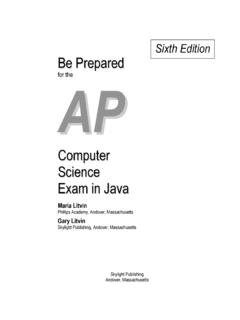Transcription of RtI and the Special Education Eligibility Process
1 RtI and the Special Education Eligibility Process Frequently Asked Questions April 2009 2 Virginia Department of Education Office of Student Services Division of Special Education and Student Services i This document complements and extends information disseminated by the Virginia Department of Education in an earlier document entitled, Responsive Instruction: Refining Our Work of Teaching All Children, Virginia s Response to Intervention Initiative. The earlier document can be accessed at the following Web site: The Virginia Department of Education does not mandate or prescribe a particular Eligibility form or format. The information contained herein is provided only as a resource that educators may find helpful and use at their option in guiding their Special Education Eligibility determination Process . Superintendent of Public Instruction Dr. Patricia I. Wright Assistant Superintendent for Special Education and Student Services H.
2 Douglas Cox Office of Student Services Office of Special Education Instructional Services Dr. Cynthia Cave, Director Dr. Patricia Abrams, Director 2009 Commonwealth of Virginia Department of Education The Virginia Department of Education does not discriminate on the basis of race, color, national origin, sex, age, or disability in employment or provisions of service. iiAcknowledgements The Virginia Department of Education (VDOE) wishes to acknowledge all those who provided assistance in the development and review of the RtI and the Special Education Eligibility Process monograph. This group included parents, general and Special educators, administrators, and various VDOE offices. Their feedback assisted the department in the development of a document designed to be a useful resource and a supplement to the VDOE RtI initiative guidance document: Responsive Instruction: Refining Our Work of Teaching All Children.
3 IiiPreface In November 2007, the Virginia Department of Education issued a guidance document on Response to Intervention (RtI) to every Local Educational Agency (LEA) in Virginia. That document, Responsive Instruction: Refining Our Work of Teaching All Children, defined RtI as an instructional framework that embraces both general and specialized Education practices. The guide identified five essential components of responsive instruction: sound core instruction, universal screening, tiered intervention and support, student progress monitoring, and fidelity of implementation. This Frequently Asked Questions (FAQ) monograph is designed to provide supplementary guidance to Responsive Instruction: Refining Our Work of Teaching All Children by answering technical questions regarding RtI and the Special Education Eligibility Process . It should be read in conjunction with the primary guidance document. If implemented with fidelity within the general Education setting for a child being referred for evaluation because of a suspected disability, the RtI Process should provide additional information that could be critical in assisting LEAs in making Special Education Eligibility decisions.
4 Special Education administrators should have a clear and concise understanding of how this information should be viewed and used in the Special Education Eligibility Process to ensure that regulatory procedures are followed and non-compliance is avoided. RtI information should be used to ensure that Eligibility decisions are made based on multiple sources of data and the educational needs of the student. Doing this decreases the impact of assessment biases, or the lack of quality instruction. VDOE recognizes that it is virtually impossible to answer all the questions that may arise about RtI and the Eligibility Process in this document. Additional information is available through the VDOE Office of Special Education Instructional Services at (804) 225-2707, the toll free voice number (804) 422-2083, or VDOE s toll free TDD number (800) 422-1098. This document will be available at the following VDOE Web Site: 1 question #1: Which provisions in the federal regulations implementing the Individuals with Disabilities Education Improvement Act (IDEA) establish the use of a RtI Process in determining a student s Eligibility for Special Education services?
5 The use of RtI as an instructional intervention model is supported in several provisions of the federal regulations implementing the IDEA, most notably at 34 CFR - 1 According to the federal regulations, the school team reviewing a child s performance may use a Process based on the child s response to scientific, research-based interventions. As the Department of Education has stated in its commentary on these requirements, this review may not delay evaluations of a child suspected of having a disability. (Fed. Reg., p. 46657-46658, August 14, 2006). The review of the child s response to scientific, research-based interventions may result in the team referring the child to the Special Education administrator or designee for an evaluation to determine if the child is eligible for Special Education and related services. The federal and state law and regulations governing Special Education also require the Eligibility determination for Special Education and related services be made on an individual basis by a group of qualified professionals and parents.
6 This Eligibility group is expected to follow specific and consistent procedures as detailed in the regulations governing Special Education for determining Eligibility and educational need. The Eligibility group is required to draw upon information gathered from a variety of sources and ensure that the child is observed in the child s learning environment. (34 CFR ; ; ). The Eligibility group must consider, as part of the evaluation, data that demonstrates that the child was provided appropriate high-quality, research-based instruction in general Education settings and that the instruction was delivered by qualified personnel. (34 CFR ; ; ). question #2: Must Local Educational Agencies (LEAs) provide RtI practices or activities? The IDEA regulations at 34 CFR delineate that the state must provide criteria for determining whether a child has a specific learning disability, and that said criteria: a) Must not require the use of a severe discrepancy between intellectual ability and achievement 1 Federal regulations present RtI in the framework of the category of Specific Learning Disability.
7 Virginia, however, does not restrict RtI to this category of Special Education alone. 2b) Must permit the use of a Process based on the child s response to scientific, research-based interventions (RtI) c) May permit the use of other alternative research-based procedures for determining whether a child has a specific learning disability (emphasis added). This section seems to leave open the possibility that LEAs need not develop RtI practices or processes. VDOE, however, fully embraces the concept as permitted in the federal regulations that RtI is a viable option for school-based teams to consider in responding to the educational needs of children, including children who may later be suspected of having a disability. In addition, as documented in Responsive Instruction: Refining Our Work of Teaching All Children ( ), several provisions of the Code of Virginia at :1 (Standards of Quality), and the Regulations Establishing Standards for Accrediting Public Schools In Virginia (8 VAC 20-131-310), support the development of instructional practices consistent with RtI practices.
8 If LEAs align their instructional practices to these documents, they are already well on the way to adopting RtI practices. Federal law promotes the use of RtI activities and procedures in cases where a child is suspected of having a specific learning disability (emphasis added). RtI as defined by Virginia encompasses sound instructional practices and evidence-based interventions that would benefit any child in educational need. As such, the student data could be of benefit for any child referred for consideration of Special Education Eligibility , while considering the respective disability definitions and Eligibility requirements. Responsive Instruction: Refining Our Work of Teaching All Children extends the use of RtI s application to all children. question #3: Who is responsible for implementing RtI practices in a LEA? The superintendent and the team of individuals in the LEA who oversee general and Special Education services and monitor the effectiveness of instruction and intervention efforts in the school division are responsible for RtI practices.
9 At the building level, the school principal and student progress monitoring team (student focused problem-solving team) are responsible for implementing RtI practices. The student progress monitoring team oversees the RtI Process at the school level. It ensures the provision of sound core instruction in the classroom, oversees universal screenings for identifying struggling learners, provides a tiered system of intervention, and ensures the frequent monitoring of student progress. Additionally, and in accordance with VDOE s 3 Responsive Instruction: Refining Our Work of Teaching All Children, a school s student progress monitoring team ensures that the RtI Process is a collaborative one that includes parents. The progress monitoring team develops a plan that identifies a student s learning or behavioral problem, addresses the amount and duration of Education services that will be provided in the RtI Process , and the nature of student performance data that will be collected to determine the effectiveness of the intervention.
10 VDOE s guidance document suggests that four to eight weeks of formative assessment data in the areas of concern at each tier of intervention is a reasonable amount of time to (p. 35) These instructional interventions should be conducted with a high level of fidelity prior to convening any team to consider a child s need for evaluation for a suspected disability. As part of progress monitoring, the team must provide documentation that research-based instruction has been delivered, repeated assessment of achievement at reasonable intervals has been conducted, and student progress data has been systematically collected and analyzed ( ). (See Appendix A: Sample Documentation of RtI Activities) In summary, RtI practices should be delivered in the local school building, guided by a multidisciplinary team. (Responsive Instruction: Refining Our Work of Teaching All Children, pp. 37-47) question #4: How is RtI used in the Eligibility Process ? RtI can be useful in the Eligibility Process in the following ways: By helping the Eligibility group decide if more evaluation data is needed By documenting that the student was provided appropriate high-quality research-based instruction in general Education settings, and that the instruction was delivered by qualified personnel By providing data to the Eligibility group as one part of the evaluation Process used to determine if the student has a disability that requires Special Education and related services.















